Corentin Cadiou @ Heidelberg 2024
Postdoc @ Lund University
Soon “Chargé de recherche ”CNRS @ IAP, Paris


Modelling of high-\(z\) emission lines & kinematics


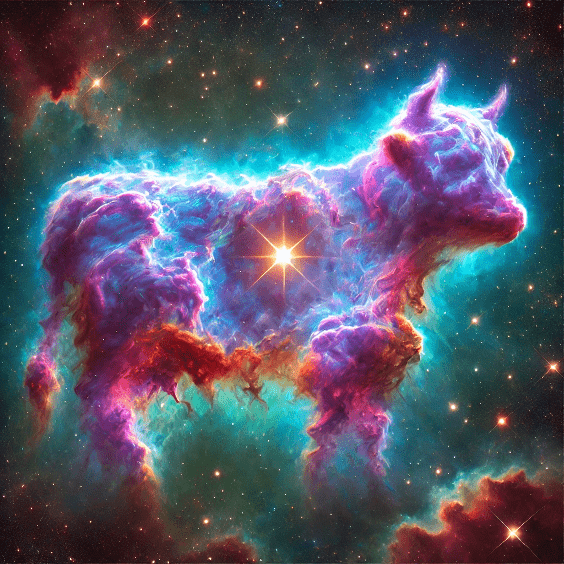
Today's talk, in a nutshell
(My) route to high-\(z\) kinematics
- Effect of cosmo. env. (Musso+19, Kraljic+20,21, Cadiou+21, Storck+24)
- Cosmology-galaxy connection (Cadiou+21)
- Cosmological accretion (Cadiou+19, Kocjan+24)
- But what are we actually observing? This talk




Low grav. tides
Large grav. tides
- cosmological environment \(\sim 50-100\,\mathrm{Mpc}\)
- resolve Strömgren spheres \(\sim 10\,\mathrm{pc}\)
- radiative-transfer
- proper multi-phase ISM \(T \lesssim 10^4\,\mathrm{K}\)
- Track ion abundances out-of-equilibrium
Wishlist for proper modelling of emission lines + kinematics
Background: Vintage Gordon (follow-up of Vintergatan) simulation
(PI: Cadiou)



\(t_\mathrm{chem} \propto 1/n^2\)
\(t_\mathrm{dyn} \propto 1/\sqrt{n}\)
\(t_\mathrm{burst} \sim 10-100\,\mathrm{Myr}\)
How we typically model emission lines

Lots of assumptions
(equilibrium, geometry, element abundances, …)
See Aniket's talk (I guess?)
\(\rho, T, Z,v\)
sometimes \(n_\mathrm{H}, n_{\mathrm{HI}}, n_\mathrm{HeI}, n_\mathrm{HeII},n_\mathrm{HeIII},\)
Processes that control ion and molecular properties:
- Collisional, photo, cosmic-ray ionization
- Radiative, dielectronic, dust recombination
- Charge exchange

RAMSES-RTZ + PRISM: Non-equilibrium chemistry coupled to on-the-fly radiative transfer
Processes that control gas temperature:
- Cosmic-ray, photo, photo-electric, H2, dust heating
- Primordial, \(\mathrm{H}_2\), CO, metal, dust* recombination, dust-gas collisional cooling
- Adiabatic (expansion), shocks (e.g. SN, turbulence), gravitational, etc.
Image: Cadiou/Katz/Rey+in prep


Model [i]
- Based on RAMSES-RT (Rosdahl+13)
- Out-of-equilibrium chemistry (Katz 23)
Primordial species: \(\text{H~{\small I}-{\small II}}\), \(\text{He~{\small I}-{\small III}}\), \(e^{-}\)
Metal ions: \(\text{C~{\small I}-{\small VI}}\), \(\text{N~{\small I}-{\small VII}}\), \(\text{O~{\small I}-{\small VIII}}\), \(\text{Ne~{\small I}-{\small X}}\), \(\text{Mg~{\small I}-{\small X}}\), \(\text{Si~{\small I}-{\small XI}}\), \(\text{S~{\small I}-{\small XI}}\) & \(\text{Fe~{\small I}-{\small XI}} \)
Molecules: \(\text{H}_2\) & \(\text{CO}\) - Dust model (Rémy-Ruyer+14)
Assuming dust-to-gass ratio - Heating & Cooling
photoheating, photoelectric heating, excitation/dissociation heating, primordial, dust recombination, dust-gas collisions, metal lines- \(\text{C~{\small I}}\), \(\text{C~{\small II}}\), \(\text{N~{\small II}}\), \(\text{O~{\small I}}\), \(\text{O~{\small III}}\), \(\text{Ne~{\small II}}\), \(\text{Si~{\small I}}\), \(\text{Si~{\small II}}\), \(\text{S~{\small I}}\), \(\text{Fe~{\small I}}\), \(\text{Fe~{\small II}}\) @ \(T<10^4\,\mathrm{K}\)
- CLOUDY tables @ \(T>10^4\,\mathrm{K}\)





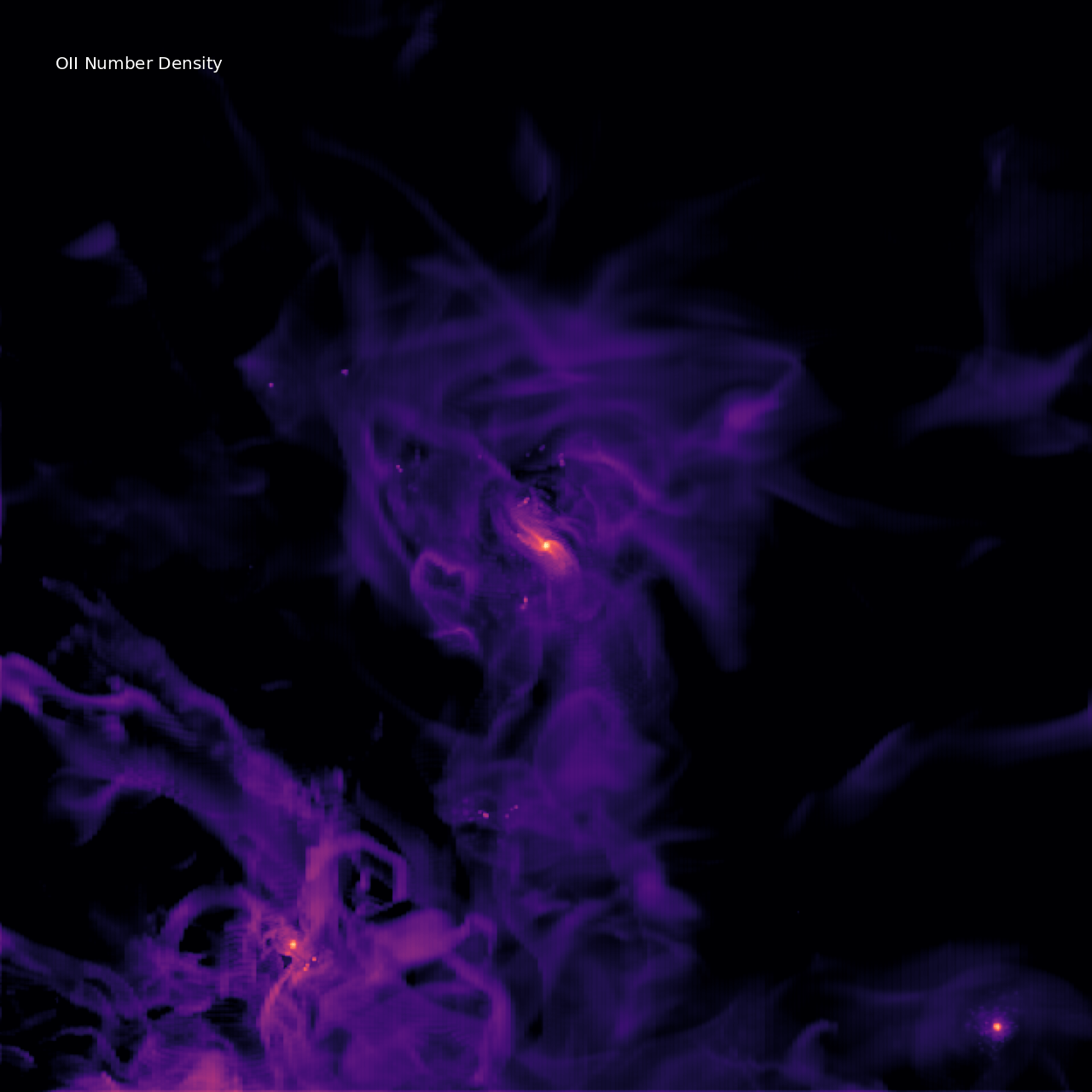



\(\text{O\small{II}}\)
\(\text{O\small{I}}\)
\(\text{N\small{I}}\)
\(\text{Mg\small{II}}\)
\(\text{Ne\small{II}}\)
\(\text{CO}\)
\(\rho\)
\(v_r\)
\(\text{O\small{III}}\)
Model [ii]
- Turbulence-based star formation (Padoan & Nordlund 11, Agertz+21)
\(\dot{\rho_\star} = \varepsilon_\star\rho/t_\mathrm{ff}\)- if \(Z<10^{-6}Z_\odot\) ⇒ Pop. III
- if \(Z\geq10^{-6}Z_\odot\) ⇒ Pop. I & II, Kroupa
- \(M_\star = 500\,\mathrm{M}_\odot\)
\(M_{\star,\rm III} \sim 100\,\mathrm{M}_\odot\) - Feedback (Agertz+21; Rey+23)
core-collapse SN, type Ia, winds + HN (Nomoto+06). - Yields (Limongi & Chieffi 18)
AGB winds (Ritter+18)

Model [iii]
- MW analogue @ \(z=0\)
- Genetically engineered to form earlier
ICs generated withgenetIC - 2 main runs
- constant physical \(\Delta x_\mathrm{min} \approx 20-40\,\mathrm{pc}\)
-
constant comoving \(\Delta x_\mathrm{min}(z=2) = 20\,\mathrm{pc}\)
\(\Delta x_\mathrm{min}(z=5)=10\,\mathrm{pc}\)
\(\Delta x_\mathrm{min}(z=14)=4\,\mathrm{pc}\)

fiducial:
few JWST targets


early-forming:
many targets
\(z>8\)
- Early forming MW mass galaxy
- \(1.6\times 10^{4}\mathrm{M}_\odot\) DM, \(500\, \mathrm{M}_\odot\) Pop. II stars, individual Pop III stars, \(1\, \mathrm{pc}\) resolution at first star formation
- IMF sampled chemical enrichment from individual stars for all relevant elements
- SN (CC, Ia, HN, PISN), Winds → follows Vintergatan (validated for MW galaxies at z = 0)
- 82 species chemistry coupled to 8 bin RT
- PRISM ISM model
- Enhanced resolution in the CGM
- Calibration sims with IMF variations and physical model variations

Introducing MEGATRON

Halo-mass—stellar-mass relation
VG: Vintergatan (Agertz+21)
⇒ Well-regulated by \(z=0\)
High-resolution early \(<1\mathrm{pc}\)
Constant resolution \(\sim 20\,\mathrm{pc}\)

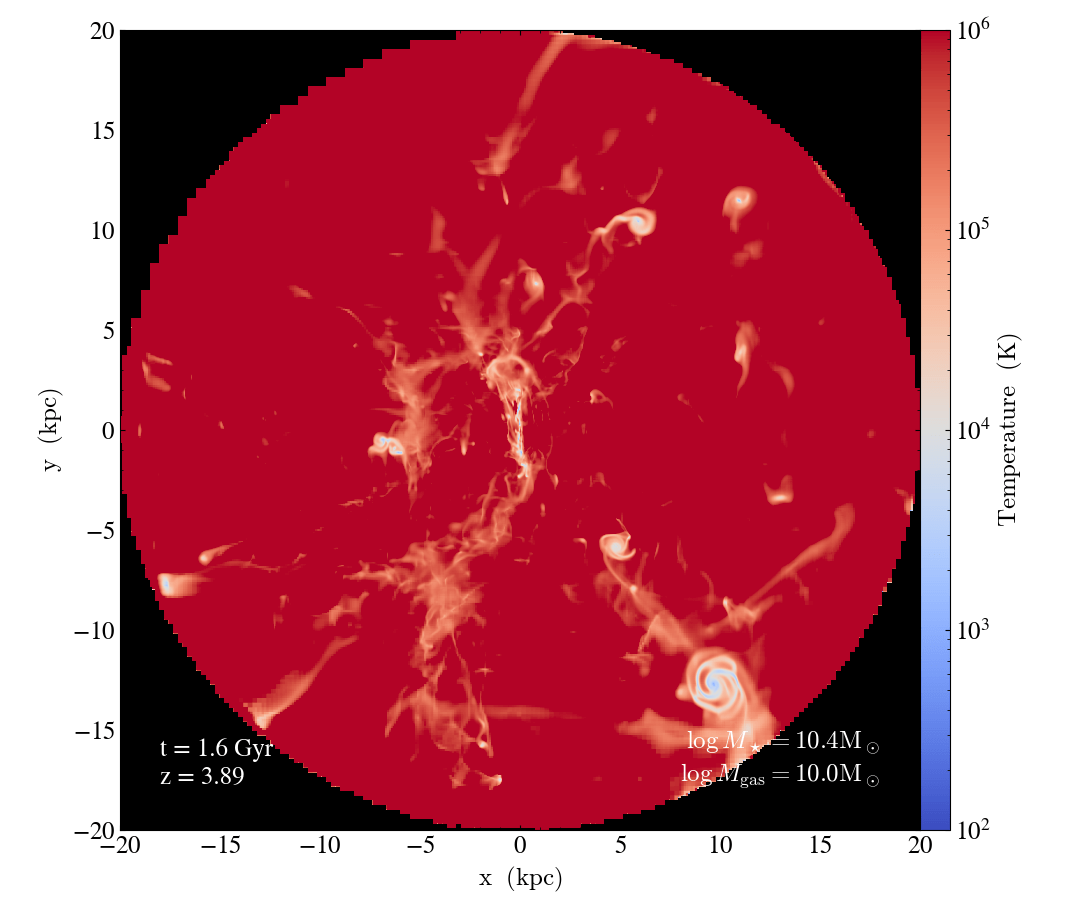

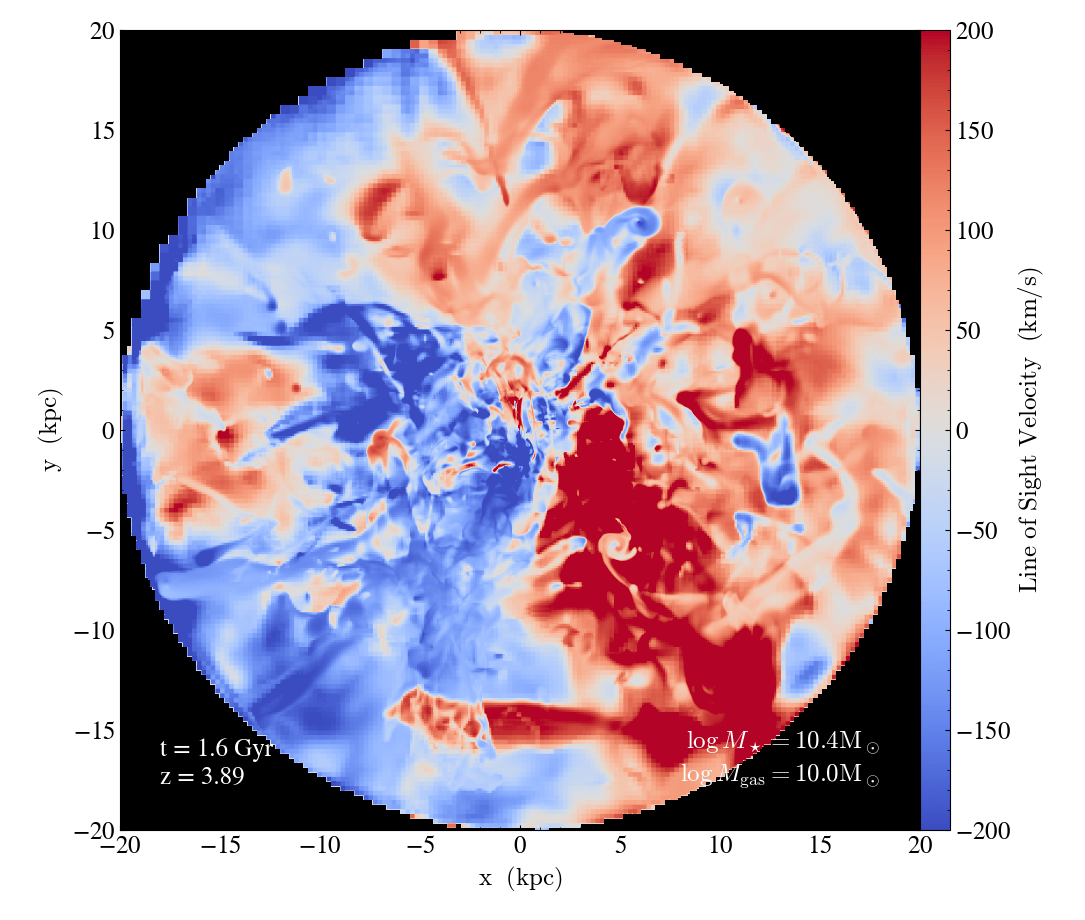


Most massive galaxy, edge-on
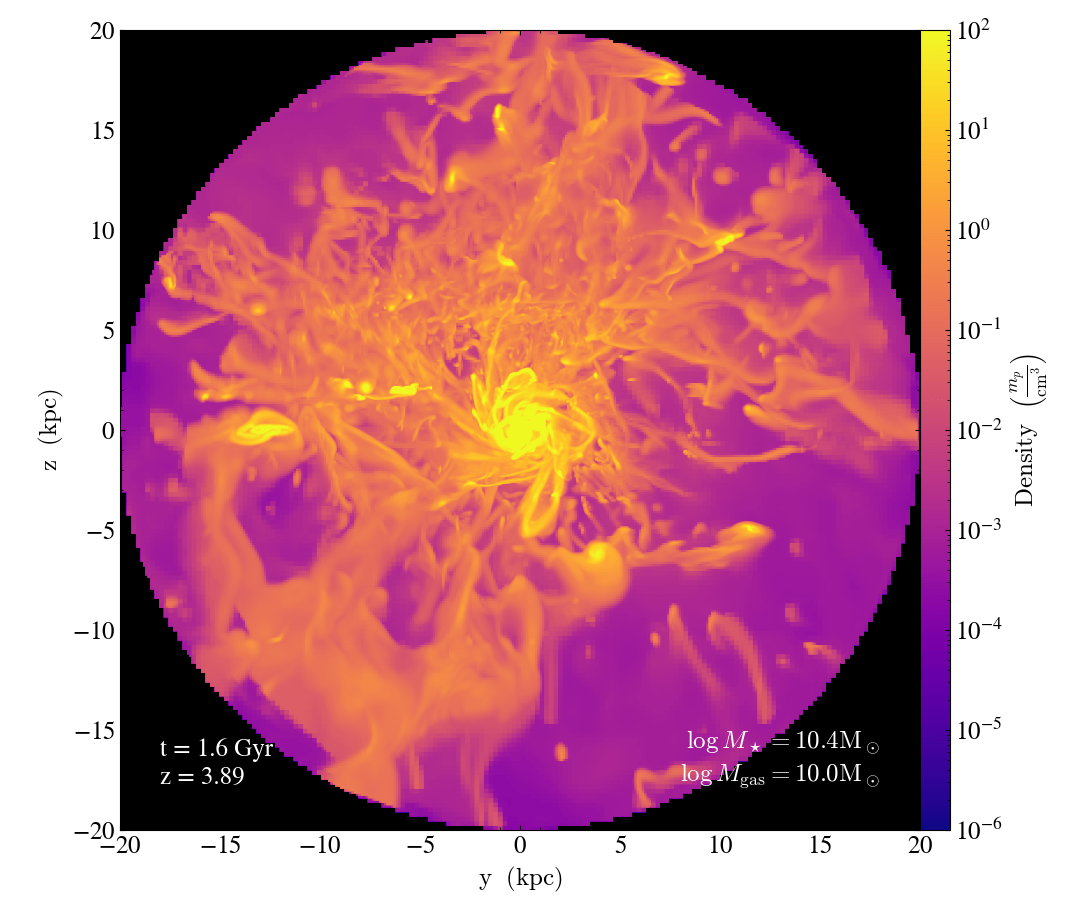
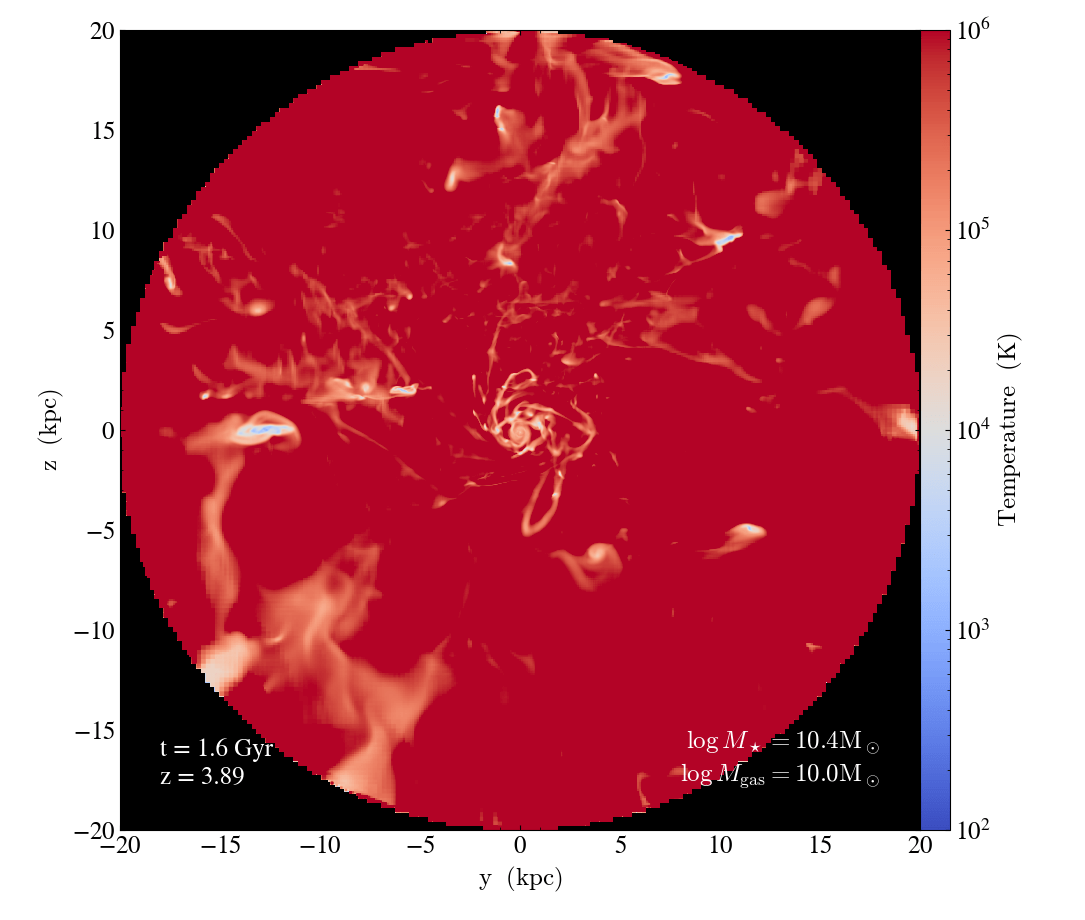


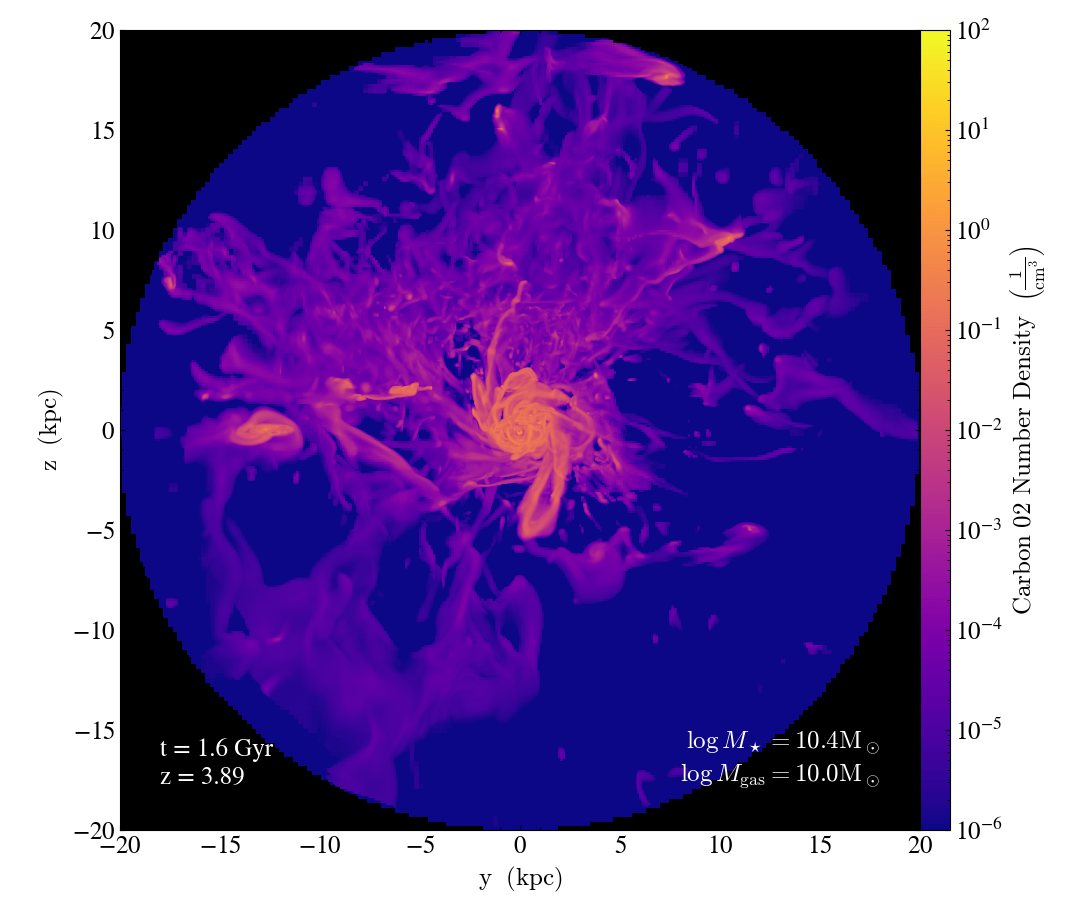

Most massive galaxy, face-on
Difference \([\mathrm{C{\small{II}}}]\)-weighted vs. \(n_\mathrm{H}\)-weighted
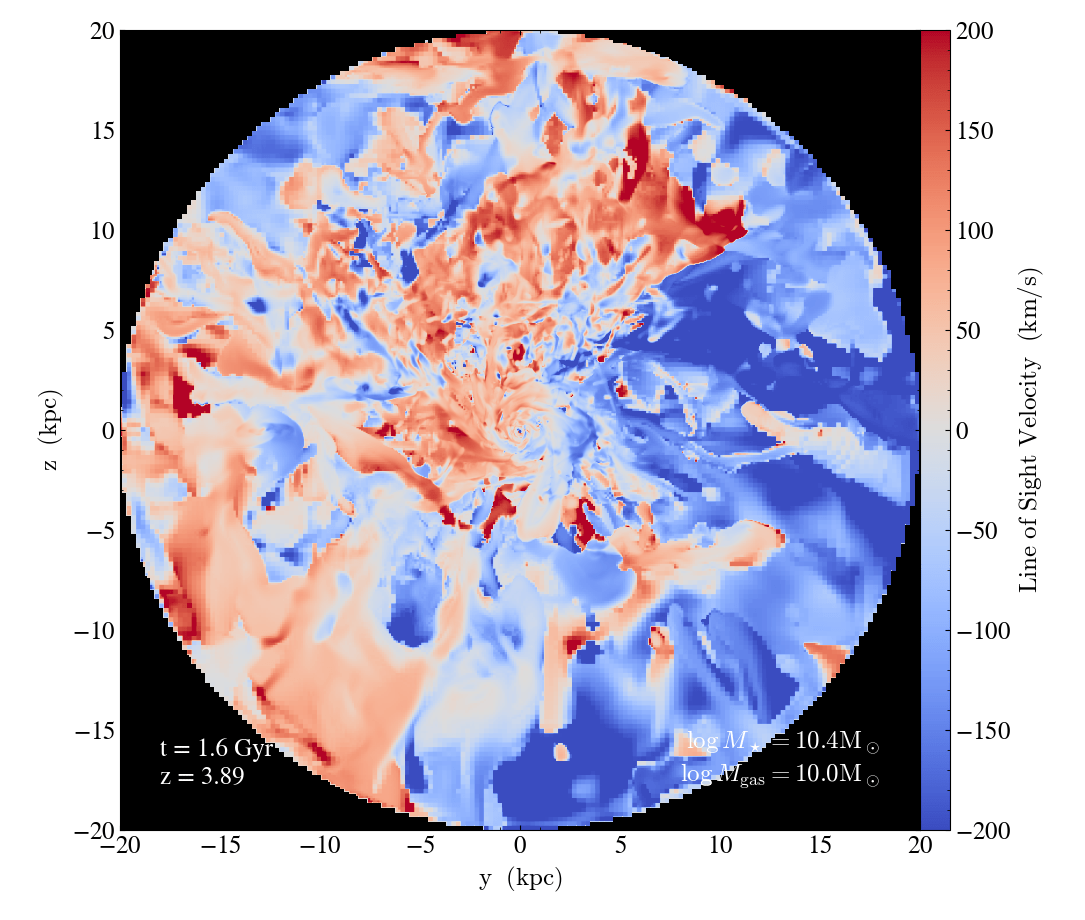
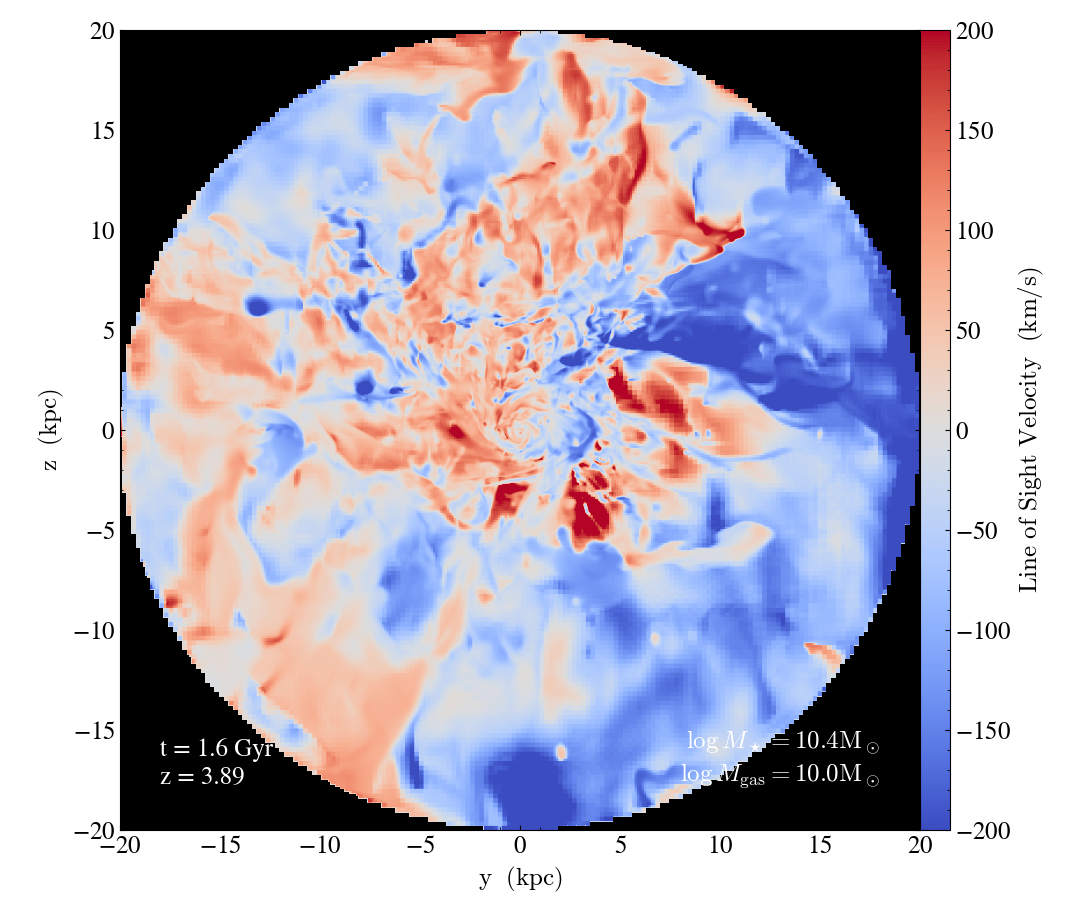
results
Stacked profiles
36 galaxies @ \(z=10\)
\(8.3\leq\log(M_\star/\mathrm{M}_\odot)\leq 10.0\)
⚠️ PRELIMINARY ⚠️
⚠️ PRELIMINARY ⚠️
⚠️ PRELIMINARY ⚠️
⚠️ PRELIMINARY ⚠️
⚠️ PRELIMINARY ⚠️
⚠️ PRELIMINARY ⚠️
⚠️ PRELIMINARY ⚠️
⚠️ PRELIMINARY ⚠️
⚠️ PRELIMINARY ⚠️
⚠️ PRELIMINARY ⚠️
⚠️ PRELIMINARY ⚠️
⚠️ PRELIMINARY ⚠️
⚠️ PRELIMINARY ⚠️
⚠️ PRELIMINARY ⚠️
⚠️ PRELIMINARY ⚠️





Only gas within \(\pm0.5\,\mathrm{kpc}\) height
All gas

Random discussion points:
“All simulations are wrong, but some are useful”
George “Simulation” Box
- How should the complex kinematics be modelled at high-\(z\)?
Non-axisymmetric structures → tilted rings not valid? What about inflows/outflows/extra-planar motions?
- Do we really need out-of-equilibrium thermochemistry?
If we do in simulation, probably also required in observation
Likely \(z\) dependent (stay tuned!)
- How can we help observers and vice versa?
Fairly easy to generate density/velocity maps, but what's needed?



Does non-equilibrium cooling matter?
Switching to equilibrium cooling
- same stellar mass, but
- ISM has much less cold gas


Katz 22
Results from Eddie
Cosmic breakfast, 2nd breakfast and elevenses challenges

Harikane+24

FOOD, Wilkins+24

Cullen+24

Cameron+24
For a better intro
see Zack's presentation
Cosmic breakfast, 2nd breakfast and elevenses challenges
What kinematics do emission lines track?
What's the Ly-\(\alpha\) escape fraction?
How to infer SFR history when spectra dominated by emission lines?
What's the structure of cold inflows?
Outflow rates?
[…]

Harikane+24

Cullen+24

Cameron+24

Me
Tracer particles
High-cadence sampling
Puns

Martin Rey
Pop II modeling
Cooling length refinment
ICs generation

Harley Katz
RAMSES-RTZ
Pop III modeling
Calibrations



Stellar mass vs. Halo mass
CP not too bad compared to Vintergatan (Rey+23)
CC underregulates
Constant comoving
Constant physical


Varying IMF to the rescue?
Same model, but high-\(z\) dwarf \(M_\mathrm{dm}=10^{9}\,\mathrm{M}_\odot\) at \(z=6\)


Pop. III star formation
Pop. III star formation
Pop. II
Pop. III


Cooling length refinment
Refining where
\( \Delta x > 2 \sqrt{\dfrac{P_\mathrm{th}}{\rho}}\times \dfrac{1}{\Lambda_\mathrm{net}},\)
(Rey+23)
- up to \(80\,\mathrm{pc}\)
- turned on at key moments
\(\Delta x = 80\,\mathrm{pc}\)
Before
After

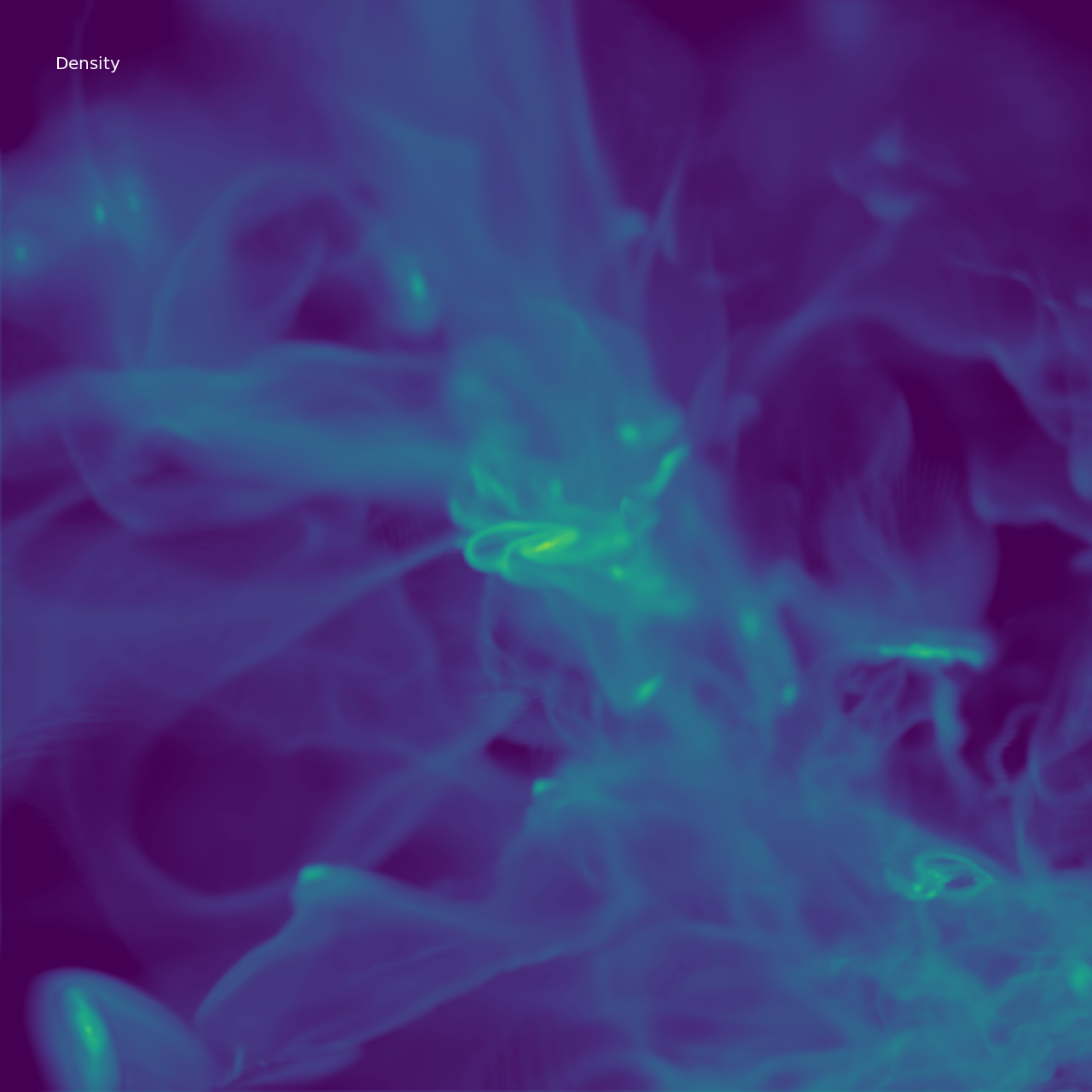
Cooling length refinment
Refining where
\( \Delta x > 2 \sqrt{\dfrac{P_\mathrm{th}}{\rho}}\times \dfrac{1}{\Lambda_\mathrm{net}},\)
(Rey+23)
- up to \(80\,\mathrm{pc}\)
- turned on at key moments
\(z=5.8\)
\(z=5.8(+2\,\mathrm{Myr})\)
\(20\,\mathrm{kpc}\)




Cooling length refinment


How much does it cost?
\(\times 3\)
\(\times 70\)!

Conclusions
It works and stay tuned for results?


Modelling high-z emission lines
By Corentin Cadiou
Modelling high-z emission lines
- 327



